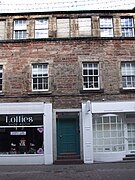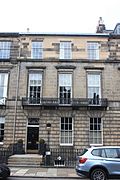Edinburgh Advertiser
| Type | Twice 4 pp. folio of the modern newspaper size |
|---|---|
| Publisher | Alexander Donaldson & John Reid; James Donaldson; Claud Muirhead |
| Editor | Andrew Crichton; Robert Chambers; Robert W. Paterson |
| Founded | 3 January 1764 |
| Political alignment | Tory[1] |
| Language | English |
| Ceased publication | 29 March 1859 |
| Headquarters | Edinburgh, Scotland |
"...the Edinburgh Advertiser is the only politico-ecclesiastico journal in the (British) empire which is against the (Church of Scotland's) General Assembly in toto".
London and Edinburgh Magazine, 1841.[2]
The Edinburgh Advertiser,[3][4][5] sometimes referred to as The Advertiser, was a twice-weekly newspaper published in Edinburgh, Scotland, on Tuesday and Friday mornings[citation needed] for almost a century, from 1764 to 1859.[6]
At the time of its inception, it was the only newspaper published on these days of the week in Edinburgh. It ran from 3 January 1764 until 29 March 1859[4] when it merged with the Edinburgh Evening Courant. Through the years, its offices were located at Castlehill; No. 91 Rose Street; No. 13 South Hanover Street;[7] 210 High Street; 15 India Street; and 7 Heriot Row.[8]
Publishers
Its first publishers were
Operations
Claud's father, James Muirhead, printer, Burgess and Guild Brother, served as the newspaper's printer, principal manager and superintendent.[8] Rev. Andrew Crichton, a Scottish biographer and historian, served as editor until 1851 when he was replaced by Robert W. Paterson. For a short period, editorial control was held by Robert Chambers.[7] At one point in time, Christopher North (the pseudonym of the Scottish writer John Wilson), was said to be associated with the Edinburgh Advertiser.[12] James Macaulay was a foreman. Journeymen printers included John Bryce, James Lamb, Robert Lamb, and George Robertson. Two of the pressmen were James Thomson and Joseph Thompson.[13]
The paper was run frugally.[14] Its initial cost was 2½d, and it was increased to 7d by 1820.[15] It covered news, religion, trade, manufacturing, agriculture, politics, and entertainment of Great Britain and the Colonial United States; it also published essays.[16] Its motto, Quidquid agunt homines, uotum, timor, ira, uoluptas, gaudia, discursus, nostri farrago libelli,[16] (translation: "whatever men do – prayer, fear, rage, pleasure, joy, running about – is the grist of my little book") is a satire by the Roman poet Juvenal.
History
The newspaper was the first to publish some historically important pieces. The first publication of Epitaph: On
See also
References
- ^ Bulloch, John; John Alexander Henderson (1892). Scottish notes and queries (Digitized 5 Aug 2005 ed.). D. Wyllie and son. p. 85.
- ^ "Anatomy of Political Parties and their Organs on Non-Intrusion". The London and Edinburgh Magazine. Vol. 1, no. 4. Cornhill: Smith, Elder & Co. 1841. p. 253.
- ^ "The Edinburgh Advertiser, Edinburgh, Midlothian, Scotland, 1772–1826". Newspapers.com. 31 January 2021. Retrieved 1 February 2021.
- ^ a b "The Edinburgh advertiser". Library of Congress. Retrieved 1 February 2021.
- ^ "Google News Archive Search". news.google.com. Retrieved 1 February 2021.
- ^ "Newspapers". National Library of Scotland. Retrieved 1 February 2021.
- ^ a b Couper, William James (1908). The Edinburgh periodical press: being a bibliographical account of the newspapers, journals, and magazines issued in Edinburgh from the earliest times to 1800. Vol. 2 (Digitized 14 Aug 2007 ed.). E. Mackay. pp. 106–114.
- ^ a b "Scottish Book Trade Index (SBTI)". nls.uk. National Library of Scotland. Archived from the original on 3 August 2009. Retrieved 18 April 2010.
- ^ Couper, P. 106
- ^ Boase, Frederic (1897). Modern English biography: containing many thousand concise memoirs of persons who have died since the year 1850, with an index of the most interesting matter. Vol. 2 (Digitized 5 Jun 2008 ed.). Netherton and Worth. p. 1906.
- ISBN 2-88124-549-8.
- ^ Wilson, John (1855). James Frederick Ferrier (ed.). The Works of Professor Wilson of the University of Edinburgh: Noctes ambrosianae. Vol. 2 (Digitized 9 Aug 2007 ed.). W. Blackwood. p. 126.
- ^ "Scottish Book Trade Index". nls.uk. National Library of Scotland. Archived from the original on 13 September 2007. Retrieved 25 April 2010.
- ^ Macaulay, James (1867). The Leisure hour (Digitized 18 Oct 2007 ed.). p. 86.
- ^ Couper, p. 106, 111
- ^ a b Couper, p. 107
- ISBN 1-84195-380-6.
- ISBN 0-8093-0919-X.




